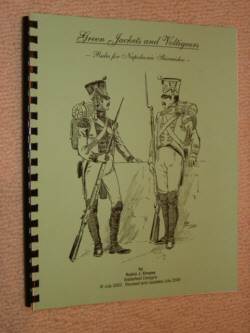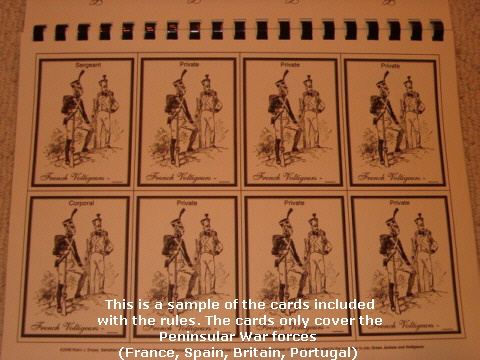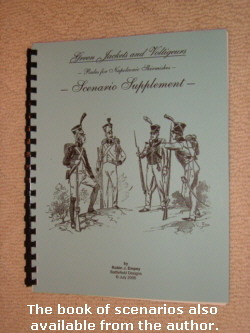|
|
|||||||||||||||
|
|
|||||||||||||||
 |
|||||||||||||||
 |
|
What’s Cooking? Bernard Cornwell’s series of historical novels about his character Richard Sharpe have certainly provided numerous gamers with inspiration for diving in to the era. Now we have an updated version of Green Jackets and Voltigeurs, a rule set specifically designed for small skirmishes during the Peninsular War. It is clearly inspired by the Cornwell books as all the examples include (very) thinly disguised versions of Sharpe and Harper.
List Of Ingredients I decided to buy both the main rule book and the scenario book. Each book comes comb bound with a plain cover of card stock. The interior pages are good quality photo copies. The rules themselves are only 18 pages long. The book includes two scenarios, record sheets, activation cards and templates. One nice touch on the templates is that both a clear plastic version and a printed version are included. If you ever need a new one, just make a copy of the printed page. There are two scenarios included to help get you started. One thing I did not like about the book however. All of the templates etc. are bound in to the rule book. This means that in order to play you have to peel the binding apart to remove them. However, there are pages you’ll want to leave in the book, so there is some reconstructive surgery you’ll have to do. I hope future printings will have these parts included as loose pages with just the templates bound in.
How Big? How Many? How Long? In keeping with the subject the rules are written for good sharp fights, up close and personal. A turn is 20 seconds, one inch on the table is 10 yards, and all games are 10 turns long. Figure ratio is 1:1 so each soldier has his own figure on the table. Scenarios are designed for 4x8 table. Basing, Braising, and Roasting: How To Given the scale, basing is not needed other than to keep figures upright. All ranges are measured from head to head so however your figures are based they will work fine here. Which Comes First, Cheese or Salad? The turn sequence is very straight forward. Each turn begins with a morale phase - usually precipitated by a casualty the prior turn. Then action points are determined - each figure rolls a D6 and then has that many action points for the upcoming turn. In GJ&V figures are activated by a card draw. Each figure has a D6 of action points that it may spend each turn. When activated a figure spends its action points to move, fire, reload etc. Once all figures have been activated the turn is over and a new one begins. There are limit on how action may be used. A maximum of three may be moved for movement, for example. Also, some actions cost more than one point to complete. Reloading a rifle takes two points, compared to a musket’s one. Leaders can play an important role as they are able to give their points to every figure within 6” (in some circumstances). They can take more wounds, and inspire the troops during the morale phase. The Gourmet Touch GJ&V’s core mechanisms are well suited to the scale and scope of the game. Essentially everything runs off of a D20. For morale, combat and melee you roll a D20, check a few modifiers, and look up the result on a simple table. For example, for morale, you roll a D20. On a 1-12 you fight on. 13-16 you’re pinned. 17-18 you retreat. 19-20 you rout. Good troops and heroes have a negative DRM, bad troops a positive. Neat and simple. Combat is likewise very easy. Find your “to hit” number by cross referencing weapon and range. Roll a D20, check your DRMs and there you are. If you score a hit roll a D20 to see the effect - light wound, heavy wound or kill. Melee is again a D20 but both players roll and high side wins. It is not clear from the rules but it appears only the loser takes a casualty (see below). It is also not clear what else happens at the end of melee. Does the loser retreat? Can the winner advance?
The Good, the Bad, and the Incomprehensible: I have read through the rules three times now, and I find I have three major issues with them. First, they are sometimes vague and incomplete. Second, the few examples extant are in the wrong places. Third, the time scale seems seriously out of whack with the action points and ground scale. Let me address each in turn. In common with many self published rules sets, GJ&V suffers from a lack of serious editing and proofreading. While the rules seem simple enough they have some rather large holes. For example in melee each player rolls a D20, high die wins. The rules then state “The effect of the melee is resolved on the Effects of Hits Chart listed below.” Firstly the chart below is “Effect of Melee Chart” but I’ll pass over that. The chart is a simple roll a D20 and read the result. Fair enough. But does it affect only the loser? It is nowhere explained who rolls for an effect. There is apparently no movement as a result. Neither retreats nor advances are part of melee. So I guess the figures remain in base-to-base contact unless one withdraws (?). This would be a great place for an example. Here is another smaller one. Under movement there is a note: “Artillery: It takes one movement point to limber and one movement point to unlimber.” Nowhere else are “movement points” used. Does this mean one action point? That’s mighty fast considering the gun might have as many 6 action points for a 20 second turn. A check under action points reveals that one AP is meant, but again you have to hunt for the answer. My final grudge on the incomplete/missing front is with the two provided scenarios - there are no maps for either one! The terrain is broadly described, but there are then notes about such things as “It takes 2 Action Points to search the olive grove...due to the size of these terrain features.” If the scenario were more generic, along the lines of “a hilly valley with a small village of 12 house and a church in the middle” a lack of a map might be fine. But with such specific terrain notes as this a map is definitely called for. The selection of examples is likewise poor. There are detailed examples for Play Sequence, Action Points and Movement. But there are none for small arms fire, none for artillery fire, none for melee, and none for morale checks. A thorough example of play for each of these sections - or perhaps even a “sample turn” as a separate chapter - would be a great addition to these rules. Finally, I have some issues with the stated game scales. The turn lasts about 20 seconds. A foot figure may move up to 230 yards if he uses 3 action points on movement. That’s Olympic class sprinting! Never mind in full pack, heavy gear, over uneven ground and being shot at! At the end of the day I think these are relatively minor annoyances. Given the relatively straight forward nature of the game house rules will be easy to make on the fly, and I think they will give a highly entertaining game. I have already penciled in all of my notes and as soon as I can find an opponent, we will be sniping at each other through a Spanish olive grove. Overall I think there’s a good game here, but for $40 I usually expect a little more.
Where to Get Help If the Smoke Alarm Goes Off The author has no web site as yet nor a dedicated support forum. Robin has always been very responsive to e-mail here, or you can drop by the Nap Skirmish Yahoo group or post on TMP. |
 |
|||
|
|
|||


